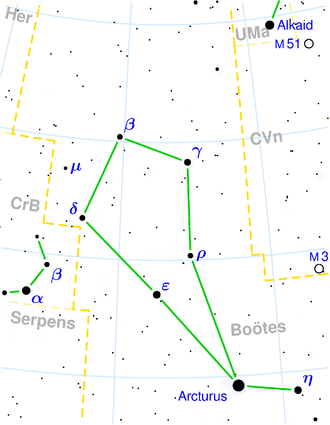Bootes-II-Zwerggalaxie
| Galaxie Bootes II Dwarf Galaxy[1] | |
|---|---|
| AladinLite | |
| Sternbild | Bärenhüter |
| Position Äquinoktium: J2000.0, Epoche: J2000.0 | |
| Rektaszension | 13h 58m 00s[1] |
| Deklination | 12° 51′ 00″ [1] |
| Erscheinungsbild | |
| Morphologischer Typ | dSph [2] |
| Helligkeit (visuell) | 15,8 ± 0,5 mag [2] |
| Winkelausdehnung | 8,0' +2,2'/-2,8' [3] |
| Physikalische Daten | |
| Zugehörigkeit | Lokale Gruppe |
| Entfernung | 136.000 ± 7.000 Lj / 42.000 ± 2.000 pc [3][4] |
| Metallizität [Fe/H] | −1,8 [2][5] |
| Geschichte | |
| Katalogbezeichnungen | |
| Boo II[3] | |
Bootes II (kurz auch Boo II) ist eine spheroidale Zwerggalaxie (dSph) im Sternbild des Bärenfängers. Sie wurde im Jahr 2007 in Aufnahmen der Durchmusterung des Sloan Digital Sky Survey entdeckt.[2] Die Galaxie befindet sich in einer Entfernung von etwa 42 kpc von unserem Sonnensystem und bewegt sich mit 120 km/s auf die Sonne zu.[2][5] Als spheroidale Zwerggalaxie besitzt sie eine annähernd runde Form mit einem Halblichtradius von lediglich 51 pc[3] (andere Quellen nennen sogar bloß 36 pc).[4]
Eigenschaften
Leuchtkraft
Bootes II ist eine der kleinsten und lichtschwächsten Satellitengalaxien unser Milchstraße (nur Segue 2 und Willman 1 sind lichtschwächer).[3] Die integrale Leuchtkraft ist mit MV = -2,7m etwa nur 1000-mal so stark wie diejenige der Sonne, die Leuchtkraft liegt damit unter derjenigen der Mehrheit der Kugelsternhaufen.[3] Die Masse der Zwerggalaxie ist jedoch deutlich signifikanter aufgrund des hohen Masse-Leuchtkraft-Verhältnisses von mehr als 100, was auf eine hohe Dichte an Dunkler Materie schließen lässt.[4]
Metallizität
Die Sternpopulation von Bootes II besteht hauptsächlich aus älteren Sternen, die vor 10 bis 12 Milliarden Jahren entstanden sind.[5] Die Metallizität dieser alten Sterne ist mit [Fe/H] = −1,8 gering. Sie besitzen 80-mal weniger schwere Elemente als unsere Sonne.[4][5] Zurzeit ist in Bootes II keine Sternentstehung festzustellen. Auch konnte bis jetzt kein neutrales Wasserstoffgas in der Zwerggalaxie gemessen werden (Obergrenze hierfür sind lediglich 86 M☉).[6]
Zugehörigkeit
Bootes II ist nur 1,5° (entspricht 1,6 kpc) entfernt von Bootes I.[2] Es ist jedoch unwahrscheinlich, dass die beiden Galaxien physisch gekoppelt sind, da sie sich in Bezug zur Milchstraße in entgegengesetzte Richtungen bewegen und dies mit der doch hohen Relativgeschwindigkeit von 200 km/s. Es erscheint jedoch eher wahrscheinlich, dass Bootes II Teil des Sagittarius-Stroms ist und damit eher eine Satellitengalaxie oder sogar nur ein vor 4–7 Milliarden Jahren entzogener Kugelsternhaufen der Sagittarius-Zwerggalaxie ist.[5]
Weiteres
Weblinks
Einzelnachweise
- ↑ a b SIMBAD Astronomical Database. In: Results for Bootes II. Abgerufen am 13. Februar 2010.
- ↑ a b c d e f S.M. Walsh, Jerjen, H.; Willman, B.: A Pair of Boötes: A New Milky Way Satellite. In: The Astrophysical Journal. 662, Nr. 2, 2007, S. L83–L86. arxiv:0705.1378. bibcode:2007ApJ...662L..83W. doi:10.1086/519684.
- ↑ a b c d e f N. F. Martin, De Jong, J. T. A.; Rix, H. W.: A Comprehensive Maximum Likelihood Analysis of the Structural Properties of Faint Milky Way Satellites. In: The Astrophysical Journal. 684, Nr. 2, 2008, S. 1075. doi:10.1086/590336.
- ↑ a b c d S.M. Walsh, Willman, B.; Sand, D. et al.: Boötes II ReBoöted: An MMT/MegaCam Study of an Ultrafaint Milky Way Satellite. In: The Astrophysical Journal. 688, Nr. 1, 2008, S. 245–253. arxiv:0712.3054. bibcode:2008ApJ...688..245W. doi:10.1086/592076.
- ↑ a b c d e Andreas Koch, Wilkinson, Mark I.; Kleyna, Jan T. et al.: A Spectroscopic Confirmation of the Bootes II Dwarf Spheroidal. In: The Astrophysical Journal. 690, Nr. 1, 2009, S. 453–462. arxiv:0809.0700. bibcode:2009ApJ...690..453K. doi:10.1088/0004-637X/690/1/453.
- ↑ J. Grcevich, Putman, M. E.: H I in Local Group Dwarf Galaxies and Stripping by the Galactic Halo. In: The Astrophysical Journalvolume=696. 2009, S. 385. doi:10.1088/0004-637X/696/1/385.
Auf dieser Seite verwendete Medien
Caption from NASA: Like early explorers mapping the continents of our globe, astronomers are busy charting the spiral structure of our galaxy, the Milky Way. Using infrared images from NASA's Spitzer Space Telescope, scientists have discovered that the Milky Way's elegant spiral structure is dominated by just two arms wrapping off the ends of a central bar of stars. Previously, our galaxy was thought to possess four major arms.
This artist's concept illustrates the new view of the Milky Way, along with other findings presented at the 212th American Astronomical Society meeting in St. Louis, Mo. The galaxy's two major arms (Scutum-Centaurus and Perseus) can be seen attached to the ends of a thick central bar, while the two now-demoted minor arms (Norma and Sagittarius) are less distinct and located between the major arms. The major arms consist of the highest densities of both young and old stars; the minor arms are primarily filled with gas and pockets of star-forming activity.
The artist's concept also includes a new spiral arm, called the "Far-3 kiloparsec arm," discovered via a radio-telescope survey of gas in the Milky Way. This arm is shorter than the two major arms and lies along the bar of the galaxy.
Our sun lies near a small, partial arm called the Orion Arm, or Orion Spur, located between the Sagittarius and Perseus arms.



